Unfortunately I missed out on the repercussions of Storm Ciaran, the amazing Leach's Petrel views off Hill Head over the weekend, we were away in a quiet Somerset. Sadly the petrel didn't make it succumbing to attacks from the large gulls. However one visitor did seem to remain and as I left for Titchfield there was news that it was still around the sea front at Hill Head, an adult Arctic Tern
When I arrived the tide was starting to fall, there was a fresh breeze and the sea was a little choppy. It didn't take long to see the Arctic Tern, or to identify it it as it was the only terns present, taking away any of the identification issues with any Common Terns. It was moving along the sea wall close in watching the tide line with Black-headed Gulls.
The Arctic Tern is famous for its migration; it flies from
its Arctic breeding grounds to the Antarctic and back again each year. The
shortest distance between these areas is 19,000 km (12,000 mi). The
long journey ensures that this bird sees two summers per year and more daylight
than any other creature on the planet.
The adults do not moult here in the northern hemisphere, this happens when they reach their wintering grounds. This bird is clearly then an adult. After migration, the birds spend their winter on pack ice.
During this time, they undergo a moult and lose most of their feathers.
Sometimes the feathers are lost more quickly than they can be replaced, and as
a result the individual is flightless for a period of time.
When ever there are Artic Terns there is always the discussion around the comparison with the Common Tern, a much more commoner visitor to the south coast. Let's address the flight with these photos and then move on to other differences later.
Arctic Terns can
show narrow wings and their tail streamers can be of much greater length than
the Common Tern. Although difficult to assess in the spring, Common terns start
to show a think dark wedge to the trailing end of their wings – it is very noticeable
from mid-summer and when in flight it can look black. Adult Arctic’s never show
this contrast as the primaries have a neat dark trailing edge and their wing
feathers are more translucent in flight.
It would follow the tide line towards Brownwich and then head out to sea where I then lost it. I bet on it having flown back towards the harbour and the sailing club, so walked in that direction. I picked it up on the far groyne on the beach behind the sailing club. I was able to walk along the beach and get some of the best shots of Arctic Tern since being on the Farne Islands a few years ago.
The light was not good to start with, but I was able to move to a better aspect. The Tern was all on its own on the groyne.
An opportunity to compare the key differences between the Arctic Tern and Common Tern on the ground, or groyne.
Common Terns have
long orange-red bills with a dark tip and it can appear long, and slightly
de-curved. Here you can see the Arctic Tern has a shorter bill and is completely blood-red in
colour. Overall this can give an impression of Arctics having a small
round-looking head
When standing the leg length of the Common Tern is much longer than
that of the Arctic Tern. There is also a subtle colour difference as Common
Terns have orange-red legs compared to the dull-red of Arctic’s, although with the back light the legs here do look brighter.
Adult Common Terns
can look rather dusky grey compared to the more uniformly pale grey of adult
Arctic Terns. Also the structure of the bird is key’ Common terns can look
bigger and bulkier compared to the more slender Arctic Tern.
The head of an
Adult Arctic tern can contrast against the white cheek more than usual, as it
is generally a slightly paler in colour compared to the dusky grey of a Common
Tern.
Some wing stretches that usually indicate it is going to fly.
A good chance to see the pristine feathers on the cap and those short legs.
As suspected it did then fly and headed along the sea wall where I caught up with it once again, then like earlier it disappeared. I decided to head towards Brownwich, but as passed the emerging Rainbow Bar I saw it settled on the shingle, so I slowly made my way along the beach to get a little closer.
And then a little closer
It was completely happy with me and even managed a call, to who, no one will know.
Aware of me, but not concerned.
The sun then came out showing better the uniform grey mantle and wings.
Then it flew off and headed back towards the harbour, where later I saw it fishing just off one of the markers.
Probably more impressive in black and white
As I walked along the beach a pair of Oystercatchers were on the tide line.
I was looking for a Great Northern Diver from the Brownwich Cliffs, but there was very little on the sea, just a few Great Crested Grebes and of course the Brent Geese. A female Kestrel was hovering level with the cliff top.
While in the fields behind me there was a family party of two adult Brent Geese and three juveniles.
With nothing moving on the sea I headed back down to the beach, where there were five Sanderling on the tideline.
And I can't resist a Sanderling.
Specially with a nice deep blue sea.
Dragging myself away from the beach I made my way on to the sea wall. Scanning the sea I noticed something large just beyond the pink buoy. Hopes raised I checked with the scope and yes Great Northern Diver, then I lost it. I walked to the east continuing to scan the sea but could only pick up a Cormorant, I was certain there had been a Great Northern Diver, but I could not locate it. Then it took off from the water and flew around until eventually flying aay to the east and out into the mid channel.
More scanning revealed this gathering of Eider on one of the sand bars.
I stooped for some lunch then decided to check out the Meon Shore Hide. The hide was empty and for good reason, this was the view from the hide across what were the two scrapes, now just one large lake.
The only birds visible were a pair of Gadwall close in on the left hand side of the hide.
I didn't stay long and as I walked towards the harbour I noticed a Sandwich Tern fishing just off shore.
I don't recall a two tern day in November before.
An adult bird that has moulted into it's winter plumage.
A lovely background created by the bushes, houses, chalets and beach.
The east side of the reserve was easier to negotiate as much of the west side has a flooded path. I stopped first in the Suffern hide where there was a brief view of a Marsh Harrier. Hoping to get better views I walked on to the Meadow Hide where like the Meon Shore Hide the view has changed but this time with some intervention from man and not the weather
There were up to three Marsh Harrier showing from the hide and hunting over the Frying Pan and the Reed Bed.
The harriers were also drawing the attention of the Carrion Crows.
But also gave some very nice fly pasts.
From size I would say this was a female, but you can never be sure with Marsh Harriers.
As well as the harriers there was a very distant Red Kite that was escorted away by the crows and a Kestrel hunting over the meadow. With the sun dropping and the harriers moving away I decided to call it a day.
As I walked past the the bottom of Duck Bay I realised that the water covering the scrapes was visible from the road.
A bizarre day where I have seen two tern species while Red Admirals fly over in November! I was also able to get two year ticks!

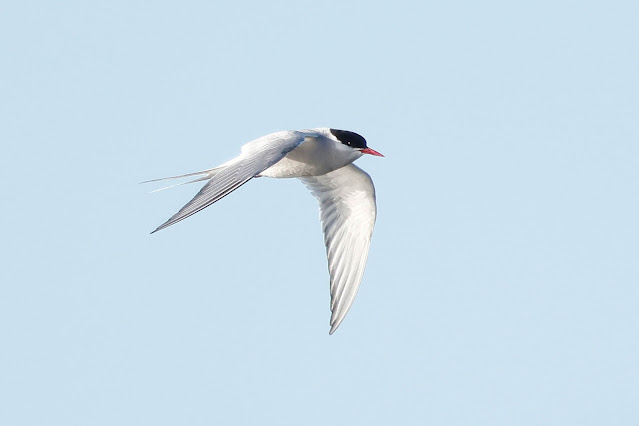


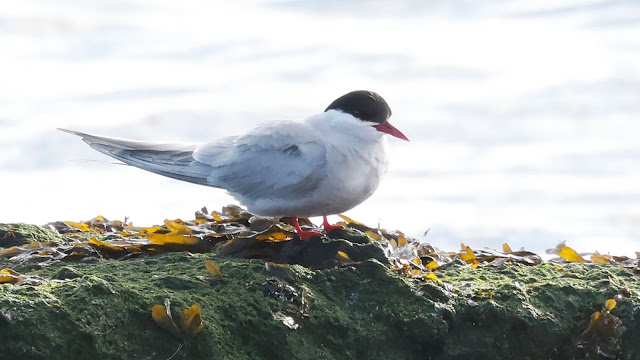





















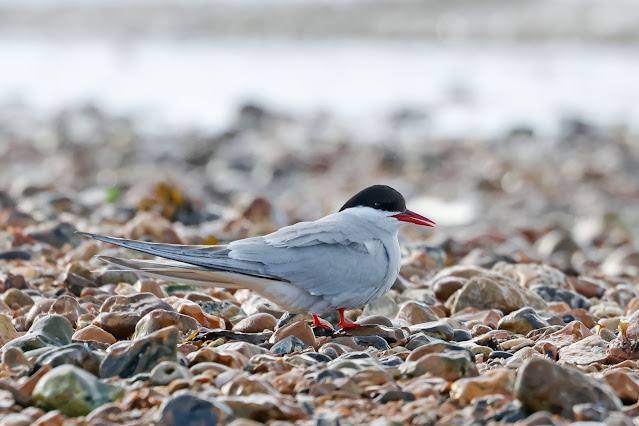




















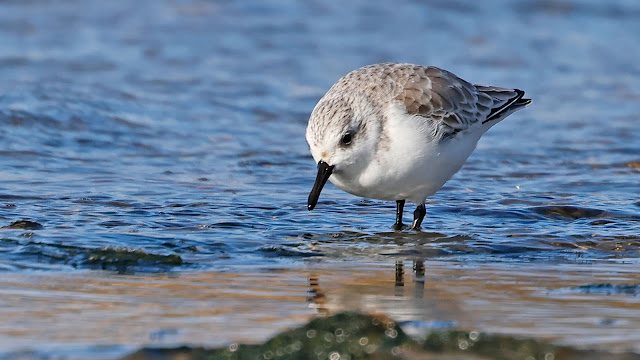













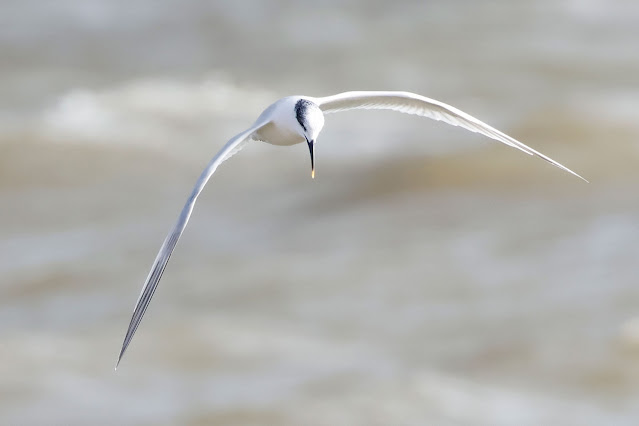











No comments:
Post a Comment